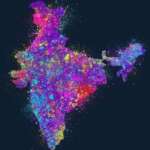As soon as I saw the word genetics, I googled it, for which I received the response as ‘The study of hereditary ….’
Oh! Is it about knowing our forefathers? – A presumed notion formed before even completing the statement.
It is the study of heredity and genes.
That’s again a new word. I need to google it and read that It occupies a fixed position on chromosomes and is the unit of heredity.
Chromosome – I know that. All my science textbooks of my schooling were filled with it. Let me explain it to you guys.
Every cell in our body has a nucleus (well, mostly until and unless they are meant to be enucleated) with other organelles like Mitochondria, Ribosomes, etc.
In this nucleus, imagine as if we are zooming into the nucleus now; we have chromosomes that contain the genetic material Deoxyribose nucleic acid (DNA).
Now, if you reread the definition of genes, it could be inferred that a set of genes, when put together to form DNA, or In this vice-versa situation, it could also be said that short sections of DNA are called genes.
See, we have started with the word genetics and came this far; that is how curiosity works. It can take you to many places. A similar thing has happened with our Gregor Mendel, which turned him into the Father of Genetics. His work on pea plants (Pisum sativum) showed that the physical characteristics (phenotype) as seed color, the shape of the seed coat, plant height, etc., are the result of underlying genotype. Both parents have equal contributions of genes to all the off-springs, but the dominance of one gene over the other causes the expression of any physical trait.
Real wonders started to happen when recombinant DNA technology came to light by the early 1970s. To understand that, let me tell you this – all genes present on DNA will code for different proteins which leave the nucleus processed by the ribosomes, and that specific protein is now available for the cell to function properly. When there is dysfunctionality, or we wish to enhance any character we desire, identifying the specific sequence and altering it works like magic.
Here is a groundbreaking story that proves the phrase – Turning the table around
Agrobacterium sps is a bacteria that causes crown galls to the plant. When any plant part is injured, the chemical secretions released can stimulate the Agrobacterium to transfer its disease-causing genetic material called T-DNA to the plant. This enters into the plant genome and gets integrated. It means that DNA always codes for galls, and whenever it multiplies, it ensures the copies of the disease are made.
Our scientists wanted to exploit this situation. Okay, you bind well with the plant genome, right? Why don’t I delete the disease-causing part and add any beneficial sequence so that it adds to the genome and ensures its expression in every subsequent generation?
Another curious step by scientists led to the start of the Human Genome Project in 1990, October 1st, that aimed to study all the genes/ gene sequences of humans that code for proteins which lasted up to April 14, 2003 (13 years). Knowing these sequences helps identify genes that cause disorders such as Alzheimer’s and cancer and address them with alterations.
I hope the scientific curiosity is nurtured well so that genetics fill colors in sapiens life.





